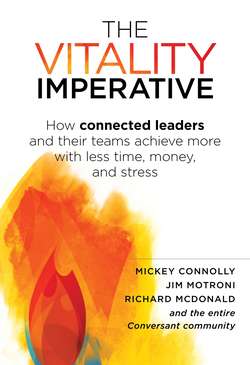Читать книгу The Vitality Imperative - Mickey Connolly - Страница 10
На сайте Литреса книга снята с продажи.
ОглавлениеPROMISE #2
EMPATHY:
The Power to Appreciate the Purposes, Worries, and Circumstances of Others
You never really understand a person until you consider things from his point of view—until you climb into his skin and walk around in it.
—Harper Lee, To Kill a Mockingbird
People believe leaders who really understand and care about their aspirations and struggles. And when people believe in their leaders, everything is easier.
—Al Miksch, CEO, Audio Precision
Every year, more than 20 million babies are born prematurely and at risk of dying. Of those premature births that do result in death, 98 percent occur in the developing world in large part because the infants cannot be kept warm.
Stanford’s design institute, known as the d.school, features a curriculum that teaches empathy as fundamental to great design. In 2007, a group of d.school students took on a formidable challenge: design a solution to neonatal hypothermia that costs less than one percent of a state-of-the-art incubator.
The students began by listening to learn the purposes, worries, and circumstances of the parents in developing regions. While visiting rural India, they discovered that many incubators went unused because the hospitals were too far from the villages. Also, midwives delivered most children at home, while hospitals were strange and feared. Even if incubators could be made more cheaply and brought to the villages, unreliable electricity was a prohibitive problem. Devoted mothers were worried about keeping their babies warm in circumstances that precluded traditional incubator solutions.
This empathetic research led to crucial criteria: any solution needed to be locally available, nonelectrical, portable, sterile, and reusable. During the discovery process, parents, midwives, and doctors at local clinics felt understood and respected, and they in turn became creative co-conspirators.
The result was an extraordinary, elegant solution that looks much like a tiny sleeping bag. Using waterproof materials like those in high-tech camping gear, the students made a hooded wrap to fully enclose the baby. An insulated sleeve in the back of the hooded wrap holds a wax-like material that can be heated in water and hold the resulting temperature for four to six hours. Close to one hundred fifty thousand babies have benefited from the solution, a product known as Embrace.
This story serves to illustrate what we’ve learned from our work with four hundred organizations in more than one hundred countries:
• People long to be understood. When you appreciate purposes, worries, and circumstances, people feel known.
• People long to be valued. When you learn from others, they feel valuable and legitimatized.
• Connecting with those deep longings unlocks contribution and causes vitality to soar.
The Economist honored the Embrace cofounders as winners of the 2013 Innovation award for social and economic innovation. Such is the power of honoring the innately human desire to be heard and valuable. True innovation begins not with assumptions and opinions; instead, it begins with deep, empathetic research that creates communities of contribution.
Imagine what putting this type of innovative empathy to work in your organization could achieve. What amazing things could happen?
How Does Empathy Produce More with Less?
The Vitality Imperative is rooted in a single principle: to align leadership practices with human nature. People are not things. They are not mechanical elements in a business process. Every time we forget that, we add time, money, and stress to work. Empathy is fundamental to our nature and yet woefully under emphasized in leadership development.
To be human is to empathize. It is the reason we care about love and war, family and work, collaboration and competition. A great Vitality leader connects to all that, and uses skillful, proactive empathy to quickly and correctly connect with another. How important is that quick and correct ability to comprehend the perspectives of others? As we shall see, it is imperative for any leader who wants greater results.
What Empathy Is Not
Many would consider empathy “soft.” We know a successful hostage team leader who would adamantly disagree.
“‘Soft’? That’s ridiculous,” he says. “If you want to resolve a hostage incident without bloodshed, you better be good at getting in someone else’s skin. When you can think their thoughts and feel what they are feeling, you can anticipate what they’ll do. And when you really ‘get’ what it is going on for them, a lot of the time they start talking and that increases the chances of finding a solution. All negotiators without empathy can do is try to get people in front of a window for a clear shot.”
This goes to show that empathy is not pity, not condescending, and is definitely not “soft.” Leaders lacking in empathy are ill-informed at best and bullies at worst. Without empathy, we resort to manipulation and spin, and squander the chance for real inspiration. The result is often a lot of organizational bloodshed.
Conversely, the tangible benefits of empathy to community, contribution, and choice are:
• Empathy improves relationships and accountability and, in turn, lowers supervision costs.
• Empathy accelerates learning
